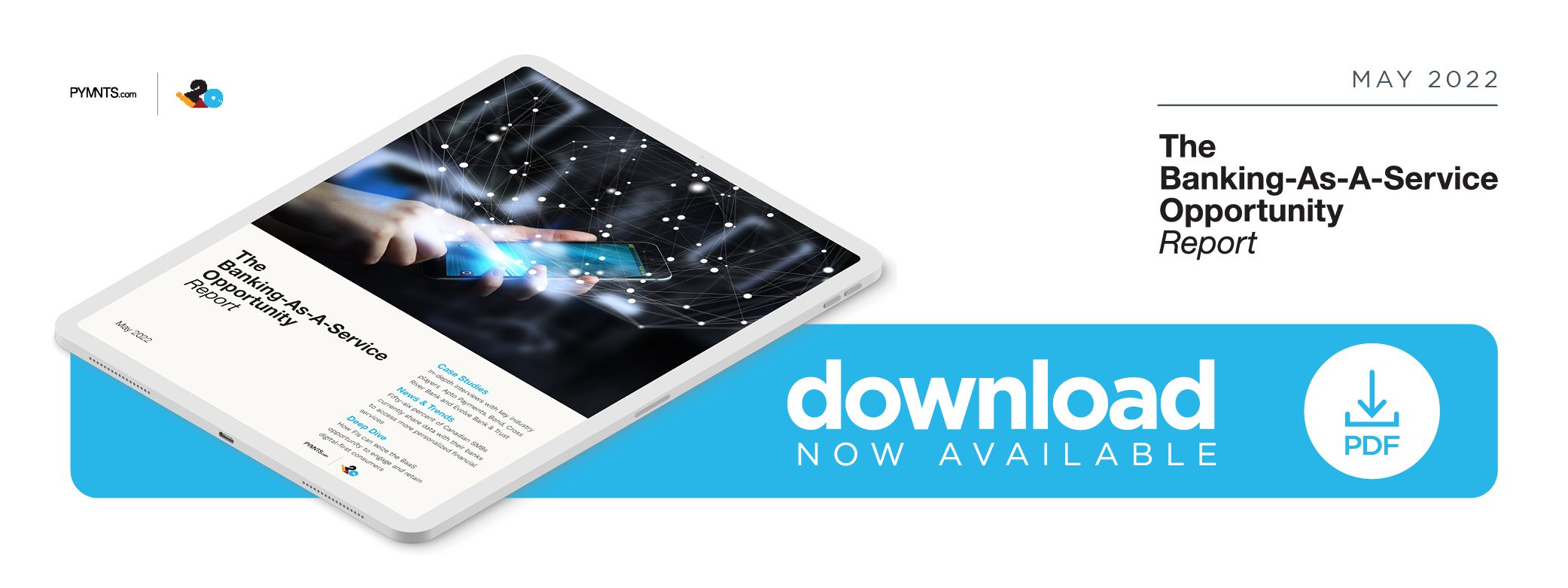How Merchants Can Tap Embedded Finance to Offer Next-Gen Solutions

PYMNTS’ new “Banking-As-A-Service Opportunity Report” examines how FIs and Banking-as-a-Service providers are creating the invisible, frictionless financial services experiences their customers expect.
Providing consumers with a smooth and frictionless payments experience has become table stakes for business success in an eCommerce-focused world. Recent events elevated the voice of the consumer in payments for the first time, pressing merchants in the United States to adopt new payment alternatives and keep pace with Europe and Asia, said Meg Nakamura, co-founder and CEO of leading-edge card-issuance platform Apto Payments, in a recent PYMNTS interview.
“Whether it’s QR code payments or contactless payments, consumers have driven change and caused merchants to adopt new technologies,” she said. “I’m not going to take away from cashiers also not wanting to be a part of that contact payment, but the pandemic has sort of helped us in the U.S. adopt new technologies and move forward in a mass-market type of way.”
Such large-scale interest among consumers in changing the way they make payments has presented hurdles that businesses typically face when trying to meet that consumer demand, according to Nakamura, especially if a business looking to embed or enhance a payment solution is working with a banking-as-a-service (BaaS) provider.
Getting Businesses up to Speed
“One of the challenges businesses face is that they don’t know what they don’t know,” Nakamura said. “And it’s not their fault. I would say that issuance and providing card solutions or payment solutions to end users has always been an opaque process, [as well as being] an expensive and [time-consuming] process. The general feeling of being overwhelmed or uncertain or maybe even thinking you’re not capable of providing these solutions is a big hurdle to get over from the side of the BaaS provider, or in our case, the current issuance provider.”
She attributed this confusion to a lack of education, asserting that it is up to BaaS providers to coach merchants and help them learn to identify what they need. The stakes are high: She explained that supporting a diverse set of seamless payment and financial tools is becoming more critical than ever for merchants to remain competitive.
“Apps like Uber have really ruined the marketplace for everybody else in the sense that consumers expect a seamless, simple and easy-to-use experience,” she said. “When things don’t work as seamlessly as Uber has made it, then you’re falling behind. If you don’t have a payment capability, your offering just falls short.”
Consequently, BaaS or embedded finance solutions can play a crucial role in meeting consumers’ payments expectations. Adopting an embedded finance solution benefits businesses, especially nonfinancial companies that have not previously been able to offer these features.
“Increasingly in your day-to-day, you’re interacting with apps to get stuff done,” Nakamura said. “And when that’s the case, the ability to pay, the ability to have the [entire] end experience in the app, is increasingly expected. And so, if businesses are not considering the payment piece of their offering, then that business offering, that product, will fall behind.”
APIs’ Creative Potential
Nakamura said that technologies such as application programming interfaces (APIs) play a crucial role in enabling embedded finance and embedded payments. She explained that they provide an infrastructural flexibility that allows FinTechs and other innovators to explore the unknown in search of the next big thing.
“I think APIs really unlock creativity,” she said. “If banks are unable to offer APIs because their technology stack is so clunky and old, then [in] working with that bank, you can only do the things they support, and it’s very constrained. If an API is available, then all of a sudden, you get to build new things. That’s the beauty of discovery.”
Nakamura added that these developments help the payments and digital financial ecosystem continue to grow and change as embedded solutions become more widely adopted.
“Because these businesses are thinking holistically as to what their customers want to do,” she said, “they’re able to provide that end-to-end experience with the new infrastructure tools that are continuing to be developed. This is going to set a new standard, kind of a new benchmark of what consumers expect.”
Nakamura stressed that while it is great that consumers are showing a preference for seamless capabilities, not all businesses fully understand payments, so it is up to BaaS and embedded finance technology providers to educate potential customers.
“Payments and infrastructure companies need to distill what’s complicated, opaque or difficult to understand and make it approachable and easy to integrate,” she said. “That’s at least how we see our value proposition and where we try to focus our energy.”
